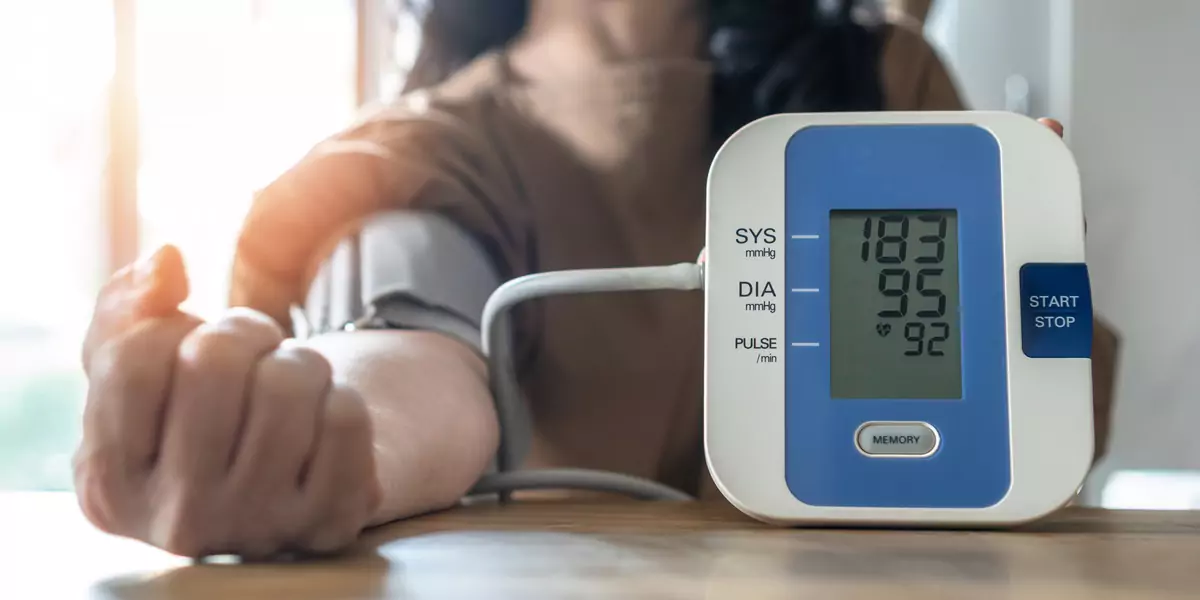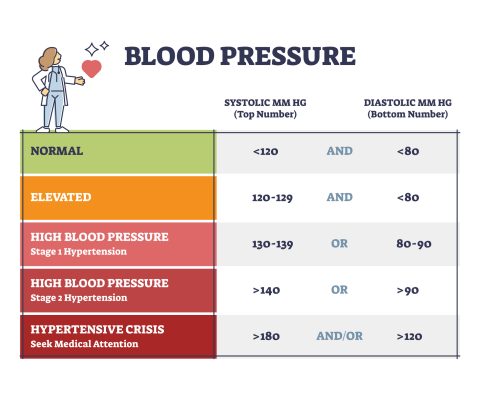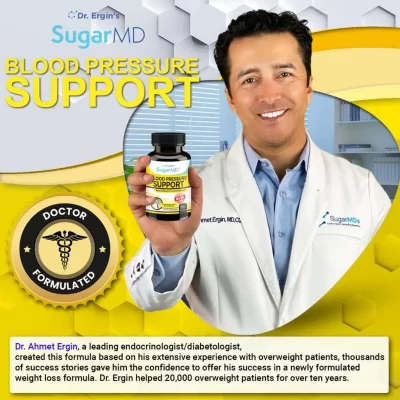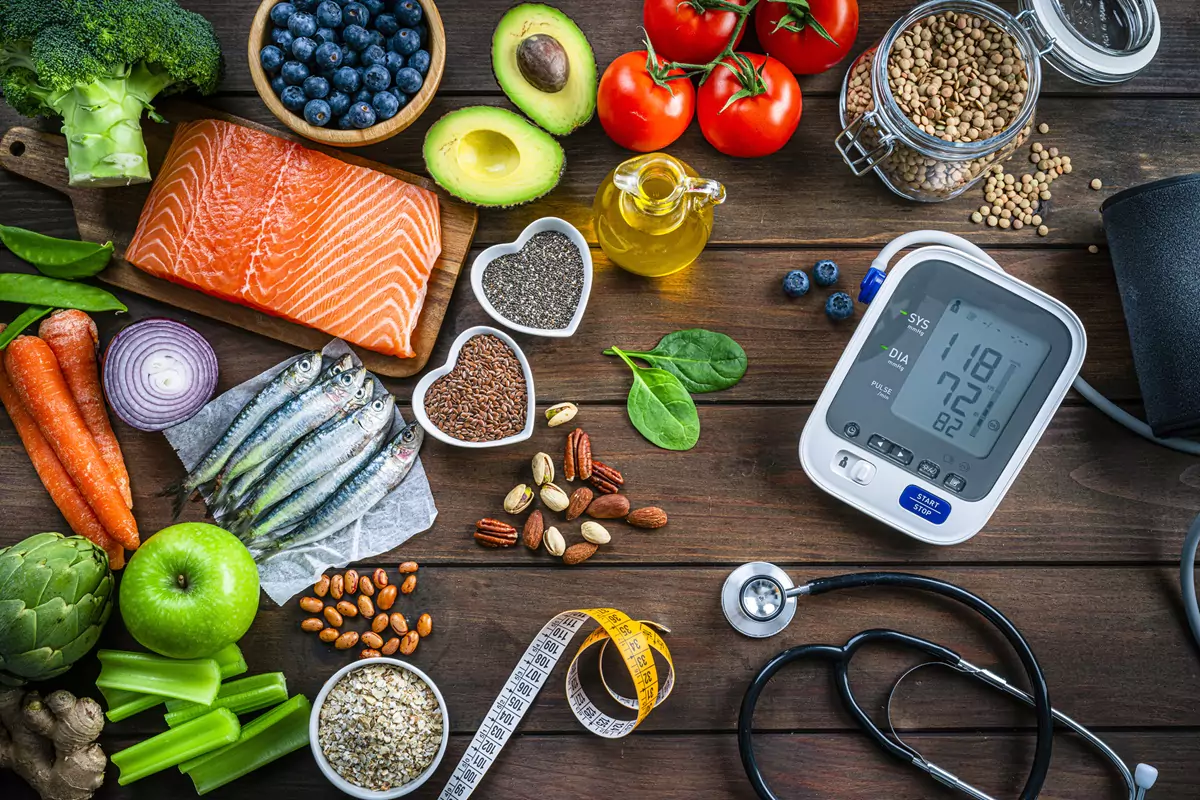





Blood Pressure Silent Killer: A Comprehensive Guide


Table of Contents
- What Is Blood Pressure?
- Why Is It Termed a Silent Killer?
- Understanding Blood Pressure Levels
- Blood Pressure Chart
- Normal Blood Pressure
- Hypertension Symptoms
- Causes of Hypertension
- Genetics
- Diet and Lifestyle
- Weight and Physical Activity
- Stress and Mental Health
- Underlying Health Conditions
- Medications and Substances
- Environmental Factors
- Hypertensive Crisis and Hypertensive Emergency
- Hypertensive Crisis: The Red Alert
- Hypertensive Emergency: When Crisis Turns Catastrophic
- Emergency Treatment for High Blood Pressure at Home
- Prevention: Your First Line of Defense
- Managing Blood Pressure Naturally
- Blood Pressure Support from SUGARMD
- High Blood Pressure Diet
- Fruits and Vegetables: Nature's Color Palette
- Whole Grains: More Than Just Fillers
- Low-Sodium Choices: Flavor Without the Risk
- Healthy Fats: Not All Fats are Foes
- High Blood Pressure Medications
- Pharmacological Support
- Personalized Approach
- Complementary Role: Part of a Team Approach
- Potential Side Effects and Considerations
- The Future of Hypertension Treatment
- Conclusion
- About The Author
Have you ever wondered why the term "blood pressure silent killer" has become a common phrase in our health-conscious society? Have you pondered what's behind the numbers when the doctor wraps that cuff around your arm? In an age where the tiniest detail about our health can be crucial, understanding blood pressure isn't just for medical professionals; it's knowledge that could potentially save lives. Let's unravel the mystery together.
What Is Blood Pressure?
Imagine a car's engine running smoothly under your hood. It's pivotal yet invisible. If the engine malfunctions, trouble's afoot. Blood pressure operates in a similar fashion. It's the force exerted by the blood against the walls of the arteries as the heart pumps it around your body. Sounds simple, doesn't it? But oh, it's a fascinating world unto itself! Think of normal blood pressure as a finely tuned symphony.
Each beat of the heart sends a wave of energy through the blood vessels, orchestrating the flow of life itself. When things are balanced, it's harmony in motion. But what happens when it's out of tune? You face hypertension or high blood pressure, or hypotension, also known as low blood pressure. This balance is vital, but understanding it requires a closer look at the key players:
- Systolic Blood Pressure: This is the pressure when the heart beats while pumping blood.
- Diastolic Blood Pressure: This represents the pressure when the heart is resting between beats.
What's considered normal blood pressure for adults may vary, but keeping these two players in harmony is the essence of well-being. From young age to old, whether looking at normal bp range for men or women, these numbers are worth watching. An aberration can signal underlying issues, not unlike the warning lights on your car's dashboard.
So, just as you would not ignore those flashing warnings on your dashboard, pay heed to your blood pressure readings. They can be your roadmap to health or an omen of underlying issues such as malignant hypertension, high diastolic blood pressure, or even a hypertensive emergency.
Why Is It Termed a Silent Killer?
Just like a snake in the grass, high blood pressure is stealthy and potentially deadly. It's a malady that often slinks around unnoticed, showing no obvious symptoms until it strikes. What does it strike, you may ask? Well, the vital organs that you need every moment of your life: the heart, the brain, the kidneys, and the eyes.
Why the ominous term "silent killer"? Because it's lurking there, maybe even right now as you read this, without your knowledge. It might not shout or scream, but it's potentially laying the groundwork for a heart attack, stroke, kidney failure, or vision loss. The scary part? You might not even know it's happening.
Many individuals with high blood pressure feel perfectly fine, going about their daily routines without a clue that this peril is building up inside their arteries. It's like a ticking time bomb, and the only way to defuse it is through regular monitoring, awareness, and proactive measures. Could this be lurking in your body? Have you checked your blood pressure lately? If not, it might be time to have a conversation with your healthcare provider about your blood pressure range, and what it means for your overall health.
Understanding Blood Pressure Levels
Knowing your blood pressure range is akin to reading a vital signpost on the road to health. It's a navigational tool, guiding you through the complex pathways of your circulatory system.
But what do all these numbers mean? How can you discern if your blood pressure is normal, high, or dangerously low? Let's embark on a journey to discover the hidden world of blood pressure levels, one where we can demystify the numbers and translate them into a language of wellness and prevention.
Blood Pressure Chart
Ever heard of a road map for your blood vessels? A blood pressure chart is just that. It's a tool that translates the complexities of your circulatory system into something you can understand and act upon. Let's explore the various elements:
- Systolic Blood Pressure: The upper number in a reading, representing the force of blood in the arteries as the heart beats.
- Diastolic Blood Pressure: The lower number, depicting the pressure when the heart rests between beats.
- Normal BP Level: Generally defined as less than 120/80 mm Hg.
- High Blood Pressure (Hypertension): Various stages that reflect increasing risk, including prehypertension and stages 1 and 2 hypertension.
- Low Blood Pressure (Hypotension): Can be a concern if it causes symptoms like dizziness or fainting.

The chart provides a snapshot of your cardiovascular health, allowing you to see where you stand on the spectrum from hypotensive emergency to malignant hypertension. It's like having a weather forecast for your heart and blood vessels, helping you prepare for potential storms or enjoy the calm weather of good health.
But what makes this chart more than just numbers and jargon? It's about interpretation and personalization. It tells you about your unique physiology, factoring in age, lifestyle, underlying conditions, and even the differences in average blood pressure between men and women. It's your guide, your gauge, and your guard against future health challenges.
Normal Blood Pressure
What's your "normal"? You might find this question a bit perplexing, but understanding the normal blood pressure for adults is a cornerstone in preventive healthcare. The concept of normalcy in blood pressure isn't a one-size-fits-all paradigm.
It varies with age, gender, physical condition, and even the time of day. Whether it's the normal bp range for men or the average blood pressure for women, it's not just a number; it's an individualized benchmark. Consider this: What's normal for a 20-year-old athlete might not be the same for a 65-year-old retiree. Your "normal" is a dynamic, ever-changing landscape, shaped by factors such as diet, exercise, stress levels, medications, and genetics.
Understanding your normal blood pressure range isn't just about satisfying curiosity; it's about empowerment. It's about knowing when to celebrate good health, when to be vigilant, and when to seek professional guidance. It's about being proactive, recognizing early signs of hypertension or hypotension, and taking steps to maintain a healthy blood pressure.
Hypertension Symptoms
Silent but perilous, hypertension symptoms are the whispers of an impending storm, a storm that builds slowly and ominously until it erupts with potentially devastating consequences. Unlike a wound or a cough, hypertension often doesn't shout its presence. It whispers, sometimes so softly that you might miss the signs altogether. So, what are these subtle signs?
- High Diastolic Blood Pressure: While it might seem technical, it's a vital clue that something might be amiss.
- Headaches and Dizziness: Often brushed off as mere annoyances, these might be your body's way of waving a red flag.
- Blurred Vision: A signal from your eyes, a plea for attention before the storm breaks.
- Shortness of Breath: It could be more than just being out of shape; it might be a sign of a heart under stress.
- Chest Pain: A cry from the heart, an urgent call to action.
What makes hypertension symptoms so treacherous is their propensity to remain hidden or be mistaken for something less severe. It's a masquerade that requires keen observation and understanding. Detecting these signs early can make a difference between prevention and catastrophe, between a life well-lived and one plagued by health problems.
Causes of Hypertension
Like threads in a tangled web, various factors contribute to hypertension. Unraveling these threads and understanding the causes of hypertension can be your key to unlocking better health. The complexity of hypertension, often referred to as high blood pressure, is not a straight path but a winding maze filled with hidden influences and visible triggers. Let's dissect the puzzle and examine the diverse factors that can lead to this silent and potentially deadly condition:
Genetics
Sometimes, the seeds of hypertension are sown even before birth, through genes passed down from your family. If your parents or close relatives have hypertension, you might be more predisposed to it. It's a silent inheritance, one that might manifest later in life but starts with the very fabric of your DNA.
Diet and Lifestyle
The foods you eat, the alcohol you drink, and even the salt you sprinkle on your meals play a role. A diet rich in sodium, unhealthy fats, and sugars can escalate the risk. Conversely, a diet that champions fresh fruits, vegetables, and whole grains can act as a defense against hypertension.
Weight and Physical Activity
Your body's composition and how you use it, whether in exercise or at rest, can either fuel or fight hypertension. Obesity strains the heart, while physical activity strengthens it. It's a delicate balance, where both excess and deficiency can tilt the scales towards hypertension.
Stress and Mental Health
The very thoughts and emotions that fill your days can silently affect your blood pressure. Chronic stress, anxiety, and unresolved emotional issues might not just weigh on your mind but also on your heart, causing your blood pressure to rise.
Underlying Health Conditions
From kidney disease to diabetes, other health challenges can be both a cause and a consequence of hypertension. These conditions are like dominos, where one triggers another, creating a cascade that might culminate in hypertension.
Medications and Substances
Sometimes, the very things meant to heal can contribute to hypertension. Certain drugs, supplements, and even recreational substances might have the unintended side effect of raising blood pressure.
Environmental Factors
Believe it or not, even the world around you can contribute to hypertension. Factors like excessive noise, pollution, or living in a challenging socio-economic environment can subtly and gradually contribute to high blood pressure. Understanding the causes is like untangling a knot, revealing pathways that lead to wellness or warning of roads that might lead to peril.
It's an exploration, an investigation into the very core of well-being. It's about being an active participant in your health, learning to recognize and respond to the silent signals of your body. What makes hypertension a formidable challenge is its multifactorial nature. It's not just one thread but a complex tapestry that interweaves genetics, lifestyle, mental health, medical history, and even the world around you. It's a condition that requires you to be vigilant, proactive, and informed.
Hypertensive Crisis and Hypertensive Emergency
When the pressure mounts beyond the red line, it's time to act. Imagine your blood vessels like a tightly wound garden hose, and the water pressure inside is climbing dangerously high. What happens if it keeps building? It could burst, leading to catastrophic damage.
That's what a hypertensive crisis is like, and understanding this situation along with the knowledge about emergency treatment for high blood pressure at home can indeed be lifesaving. Let's delve into this alarming condition to empower ourselves with knowledge and prevention.
Hypertensive Crisis: The Red Alert
A hypertensive crisis occurs when blood pressure soars suddenly to severely high levels. It's a red alert, a siren in the silent world of your circulatory system. But what numbers are we talking about here?
- Severe Hypertension: Blood pressure readings that exceed 180/120 mm Hg are considered a crisis.
The body is screaming for attention, but the symptoms might not be as loud. Headaches, nosebleeds, or shortness of breath could be your only warnings. Sounds mundane, doesn't it? But don't be fooled; this is a medical emergency.
Hypertensive Emergency: When Crisis Turns Catastrophic
A hypertensive emergency is a severe form of hypertensive crisis. It's not just about the numbers anymore; it's about the damage.
- Organ Damage: When the blood pressure skyrockets, it can cause damage to vital organs like the heart, kidneys, and brain.
- Immediate Treatment Needed: This is not a "wait and see" situation. Immediate medical attention is required.
Understanding the difference between a hypertensive crisis and a hypertensive emergency is crucial. The latter involves actual damage to the organs and requires intensive medical intervention. It's like a ticking time bomb, and the clock is ticking fast.
Emergency Treatment for High Blood Pressure at Home
Time is of the essence, and knowing what to do can make all the difference. Here's what you should consider:
- Don't Panic: Easier said than done, but staying calm helps you think clearly and act swiftly.
- Call Emergency Services: Dial your local emergency number right away. Explain the situation and follow their guidance.
- Stay Seated: Sitting down, preferably with your back supported and legs uncrossed, can help while waiting for medical help.
- Avoid Medications: It might be tempting to take extra blood pressure medication, but without professional guidance, it could worsen the situation.
While emergency treatment for high blood pressure at home is vital, remember, this is a temporary measure. Professional medical care is indispensable.
Prevention: Your First Line of Defense
Prevention isn't just a cliché; it's your first line of defense. Monitoring your blood pressure regularly, understanding the causes of hypertension, following a high blood pressure diet, and adhering to prescribed medications are steps that build a fortress against this silent killer.
Managing Blood Pressure Naturally
From your plate to your lifestyle, managing blood pressure doesn't always require a medical prescription. Nature offers a bounty of resources, and combined with the right choices, you can steer your way toward healthy blood pressure. Let's explore this multi-faceted approach that bridges dietary choices, supplements, and lifestyle changes, sculpting a harmonious path to cardiovascular well-being.
Blood Pressure Support from SUGARMD
In a world overflowing with health supplements, finding the right one can be a daunting task. Enter Blood Pressure Support from SUGARMD, your reliable ally in this journey. What sets it apart?

- Natural Ingredients: Enriched with potent natural compounds like vitamin C, niacin, hibiscus, Juniper berry, folic acid, garlic powder, and green tea leaf formula. These aren't just words on a label; they're nature's arsenal against hypertension.
- Designed by Experts: Formulated and manufactured in the USA by Dr. Ergin, a respected endocrinologist and hormone specialist, this isn't just a supplement; it's a promise of quality.
- All-Round Support: A holistic approach to supporting healthy blood pressure and heart health. It's not just about numbers; it's about well-being, vitality, and a life lived to its fullest.
- Easy to Use: With easy-to-swallow capsules, integrating Blood Pressure Support from SUGARMD into your daily routine is as seamless as your morning cup of coffee.
It's an option worth exploring, not just as a solution but as a partnership in your journey toward cardiovascular harmony.
High Blood Pressure Diet
Your fork, believe it or not, holds immense power. It can either lead you on a path of wellness or send you spiraling into health chaos. High blood pressure, or hypertension, often requires more than just medication to manage. It calls for a lifestyle change, especially in the kitchen. Let's take a culinary journey and explore how a high blood pressure diet can be both a delight to your taste buds and a guardian of your heart.
Fruits and Vegetables: Nature's Color Palette
Rich in vitamins, minerals, and fiber, fruits and vegetables are the foundational blocks of any healthful diet. In the context of high blood pressure:
- Variety is Key: Think colorful plates. Red bell peppers, leafy greens, vibrant berries - each color signifies different nutrients that play a role in blood pressure management.
- Fiber Factor: Fiber helps in reducing cholesterol levels, further supporting healthy blood pressure.
- Low in Sodium: Most fruits and vegetables are naturally low in sodium, making them perfect allies in your journey towards a healthy bp level.
- Quick Tip: Use them in salads, smoothies, or as snacks. They're versatile and delicious!
Whole Grains: More Than Just Fillers
Whole grains aren’t merely fillers in your meal; they're nutrient powerhouses:
- Rich in Nutrients: From B-vitamins to fiber and even some protein, whole grains like brown rice, whole wheat, quinoa, and oats can help in maintaining a normal bp level.
- Slow Digestion: They are digested slowly, providing a steady energy release, thus avoiding sudden spikes in blood sugar and subsequent blood pressure issues.
- Incorporation Ideas: Think oatmeal for breakfast, whole grain sandwiches for lunch, or brown rice with dinner. The possibilities are endless.
Low-Sodium Choices: Flavor Without the Risk
Sodium and high blood pressure often go hand in hand. Reducing sodium can be a game-changer:
- Spice It Up: Utilize herbs and spices like garlic, oregano, basil, or a splash of lemon. They add flavor without affecting your blood pressure.
- Read Labels: Processed foods can be sodium traps. Look for low-sodium or no-salt-added options.
- Cook at Home: Preparing meals at home gives you control over the sodium content. Experiment and enjoy the creative process.
Healthy Fats: Not All Fats are Foes
Olive oil, avocados, nuts – they're not just tasty; they're heart-friendly too:
- Omega-3s: Sources like walnuts and flaxseeds offer omega-3 fatty acids, known to help lower blood pressure.
- Monounsaturated Fats: Avocado and olive oil, rich in monounsaturated fats, can support a healthy cardiovascular system.
- Moderation is Key: While healthy, fats are still calorie-dense. Use them thoughtfully.
Remember, the path to managing high blood pressure through diet is not a bland, tasteless road. It's a journey filled with flavors, textures, and creativity. Create meals that you enjoy, experiment with recipes, and above all, celebrate the power of food as a form of medicine. From breakfast to dinner, each bite can be a step toward a healthier heart.
High Blood Pressure Medications
When lifestyle changes and diet alone aren't enough to keep blood pressure in check, it may be time to consider medications. High blood pressure medications are a vital part of a comprehensive treatment plan for many individuals. Let's delve into their role, types, and how to integrate them into a holistic approach to health.
Pharmacological Support
For some, hypertension isn't simply a matter of excess salt or lack of exercise. Genetic factors, persistent stress, and underlying health conditions can play a part. Here's where pharmacological support like lisinopril and other medications step in.
- Different Types of Medications: There are various categories of blood pressure medications, such as diuretics, ACE inhibitors, beta-blockers, calcium channel blockers, and more. Each works in a different way to reduce blood pressure.
- Prescribed with Care: These medications are carefully prescribed by healthcare professionals, keeping in mind the patient's unique situation, other health conditions, and potential drug interactions.
Personalized Approach
Medications for hypertension aren't a one-size-fits-all solution. Several factors must be considered to personalize treatment:
- Age Considerations: Different age groups might respond differently to medications. What works for a young adult may not be suitable for an older individual.
- Underlying Health Conditions: Chronic conditions like kidney disease or diabetes might influence the choice of medication.
- Lifestyle Factors: Daily habits, diet, and activity levels play a part in the decision-making process, dictating both the type of medication and the dosage.
Complementary Role: Part of a Team Approach
Medications are often most effective when part of a broader strategy:
- Working with Diet and Exercise: Healthy eating and regular physical activity can enhance the effectiveness of medications, sometimes even reducing the required dosage.
- Monitoring and Adjustments: Regular check-ups allow for continuous monitoring of blood pressure and timely adjustments to medication.
- Educating the Patient: Understanding how the medication works and its potential side effects empowers patients to take an active role in their treatment.
Potential Side Effects and Considerations
No medication is without its considerations:
- Side Effects: Some high blood pressure medications might have side effects like dizziness, fatigue, or nausea. Regular communication with healthcare providers can help manage and mitigate these.
- Cost and Accessibility: The cost of medication and the availability in local pharmacies may influence treatment choices.
- Adherence to Treatment: Consistent use according to the prescription is crucial. Skipping doses or stopping medication without professional guidance can have serious consequences.
The Future of Hypertension Treatment
Research and innovation continue to shape the landscape of high blood pressure treatment:
- Emerging Therapies: New medications and therapies are continually being developed, offering hope for even more individualized and effective treatment.
- Technology and Monitoring: Smart devices and telemedicine are providing new ways to monitor and manage blood pressure, enhancing both compliance and outcomes.
Conclusion
The odyssey from deciphering the mysteries of blood pressure to unmasking why it's dubbed the "blood pressure silent killer" has not only been enlightening but empowering. It's like embarking on an intricate maze, armed with a clear map and an understanding of the terrain.
Blood pressure is no longer an abstract concept; it's a tangible part of life that can be managed and controlled. Equipped with insights into charts, ranges, diets, supplements like Blood Pressure Support from SUGARMD, and even understanding crises and emergencies, you're now ready to take charge.
About The Author
Meet Dr. Ahmet Ergin a highly skilled and dedicated endocrinologist with a passion for diabetes care. Dr. Ergin earned his medical degree with honors from Marmara University in Istanbul. He completed internal medicine residency and endocrinology fellowship at Cleveland Clinic.
Dr. Ergin is board-certified in Internal Medicine, Endocrinology, Diabetes, and Metabolism due to his vast medical expertise. He's a certified diabetes educator, author of "The Ultimate Diabetes Book," and founder of "the SugarMD YouTube channel."
Dr. Ergin offers exceptional diabetes care to his patients in Port Saint Lucie, FL, helping them manage effectively. Disclaimer: These statements have not been evaluated by the Food and Drug Administration. Information on this website isn’t intended to treat, cure or prevent any disease. Discuss with your doctor and do not self-treat.
Written By Dr. Ahmet Ergin
461 total articles
Meet Dr. Ahmet Ergin, a highly skilled and dedicated endocrinologist with a passion for diabetes care. Dr. Ergin earned his medical degree with honors from Marmara University in Istanbul. He completed internal medicine residency and endocrinology fellowship at Cleveland Clinic. Dr. Ergin is board-certified in Internal Medicine, Endocrinology, Diabetes, and Metabolism due to his vast medical expertise. He's a certified diabetes educator, author of “The Ultimate Diabetes Book,” and founder of “the SugarMD YouTube channel.” Dr. Ergin offers exceptional diabetes care to his patients in Port Saint Lucie, FL, helping them manage effectively. For a closer look into his insights and experiences, connect with Dr. Ahmet Ergin on LinkedIn, Instagram, and YouTube.”
Disclaimer: These statements have not been evaluated by the Food and Drug Administration. Information on this website isn't intended to treat, cure or prevent any disease. Discuss with your doctor and do not self-treat.
Products









